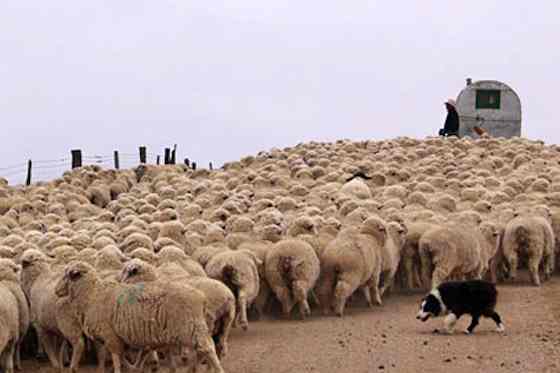- MENU
- HOME
- SEARCH
- WORLD
- MAIN
- AFRICA
- ASIA
- BALKANS
- EUROPE
- LATIN AMERICA
- MIDDLE EAST
- United Kingdom
- United States
- Argentina
- Australia
- Austria
- Benelux
- Brazil
- Canada
- China
- France
- Germany
- Greece
- Hungary
- India
- Indonesia
- Ireland
- Israel
- Italy
- Japan
- Korea
- Mexico
- New Zealand
- Pakistan
- Philippines
- Poland
- Russia
- South Africa
- Spain
- Taiwan
- Turkey
- USA
- BUSINESS
- WEALTH
- STOCKS
- TECH
- HEALTH
- LIFESTYLE
- ENTERTAINMENT
- SPORTS
- RSS
- iHaveNet.com: Pets
by Dr. Tracy Dewhirst

Many people work nine-to-five schedules, and more than 40 hours a week means overtime pay and unhappy grumbles. But a working dog -- especially a sheepherding dog -- lives to work, greeting each morning with the excitement of the first day on the job.
Dogs on the Lehfeldt Ranch in Montana embrace daily tasks with an insatiable drive that makes a 12- to 15-hour day resemble mere play. Erik Lehfeldt uses sheep herding dogs and watchdogs for his family sheep operation, just as his grandfather did and his grandfather before him. Lehfeldt, a fifth-generation sheep rancher, says his ancestors originally came from South Central Germany and used mixed-breed "mutts" and German Shepherd dogs for the ranch work. Lehfeldt questions how effective these dogs were versus the intelligent and agile Border Collies he uses today.
Check out this impressive footage of a Border Collie sheepherding dog at work at the Highland Games in Tucson, Ariz.:
Dogs have been used for ranch work for centuries, and there are still some tasks that neither man nor machine can perform better or more efficiently than the four-legged canine ranch hand. Lehfeldt has two Border Collies and 10 Akbash dogs. The Collies are the movers and shakers, helping with precision herding maneuvers. The Akbash dogs live with and protect the flock from predators.
The sheepherding dogs are up at 6 a.m., and they do not stop until the work is done. The length of the workday depends on the season. Lambing and shearing are the busiest times, but there never really is a slow day.
The Lehfeldt family has 2,000 ewes that lamb in the spring, and the entire flock is approximately 7,000 head. Shearing the sheep is no minor task, with more than 1,000 head being clipped a day. The flock must be brought into corrals so the shearing team can work quickly. Moving hundreds of unwilling sheep through gates and into small spaces takes patience, persistence and natural talent -- something with which the Collies, Fly and Loop, were born.
Fly is Lehfeldt's 8-year-old female Border Collie, and 2-year-old male pup Loop is the newest team member. Loop has been working alongside Fly for a year. Lehfeldt says the female puppies seem to mature faster, but that by age 2, gender doesn't make a difference in intelligence or stamina.
The Lehfeldts purchase their dogs from a breeder/trainer in Missouri. Training is done from early puppyhood, and the Border Collies stay with the rancher 24-7. Lehfeldt says the dogs are smarter than people and need very little training. "They have an innate understanding of their job. They just seem to know what to do and which direction to move the sheep," he says.
Fly and Loop use the standard commands for sheepherders, like the ones in the movie Babe. (And yes, that is where Lehfeldt got the inspiration for Fly's name. He readily admits Babe is one of his favorite movies.) "Away to me" means "Move out to the right"; "Come by" means "Go left"; "That will do" signifies "Down and stay"; and "Walk up" means "Move in slowly."
Of course, while "Go home" is the command humans wait to hear at work, it's the one that often disappoints dogs.
AUTOS | HOBBIES | EDUCATION | FAMILY | FASHION | FOOD & RECIPES | HOME DECOR | RELATIONSHIPS | PARENTING | PETS | TRAVEL | WOMEN
PET STORIES and PET ARTICLES ...
- Is Your Dog Cut out for Field Trials?
- Should You Crate-train Your Puppy?
- How to Play Soccer With Your Dog
- The Best Way for Your Dog to Ride in the Car with You
- Good Dog Park Etiquette
- What Is Freestyle Dancing With Dogs?
- Canicross: An Easier Way to Run With Your Dog
- Reading Your Dog's Body Language
- Kitten Kindergarten
- Tips to Keep Your Dog Safe While Flying
- Keep Your Dog Warm in the Winter
- Scottish Deerhound: The Ideal Exercise Buddy
- Teach Your Dog to Fetch
- Is Your Dog Bored?
- 7 Ways to Pamper Your Cat
- The Best Games to Play With Your High-Energy Dog
- Dog Feeding Mishaps Corrected
- How to Succeed at Off-Leash Dog Play
- ID Your Relationship With Your Cat
- Photographing Your Elusive Feline
- How to Keep Your Pet Safe During the Holidays
- When Good Dogs Turn Bad
- From Finicky Fido to Chowhound Charlie
- Insure Your Kitty's Health
- Unconditional Love: My Cat Forgives Me Every Day
- From Feline to Family Member
- Is Water From a Christmas Tree Stand Harmful to Cats?
- A Day in the Life of a Sheepherding Dog
- Go on a Desert Retreat With Your Dog
- Dog Food Goes Natural and Holistic
- Determining a Food Allergy
- Exercise Gone to the Dogs
- Find the Right Sport for Your Dog
- Make Your Dog a Part of Your Wedding
- Hydrotherapy Helps Dogs Get in Shape
- How Your Cat Says 'I Love You'
- Lost Cats Found
- De-stress Veterinary Visits for Your Cat
- Keeping Cat Food Fresh
- Second-Hand Cat, First-Rate Pet
Copyright ©
Pets | Dogs: A Day in the Life of a Sheepherding Dog